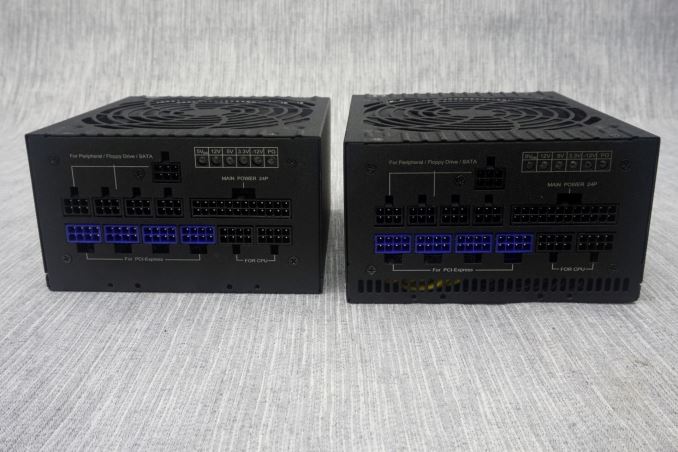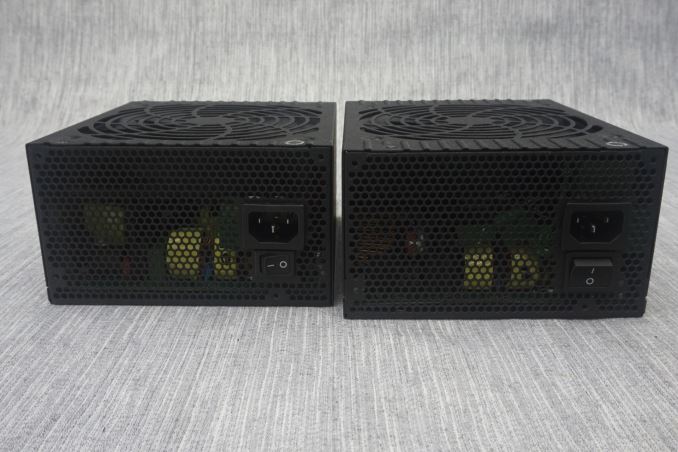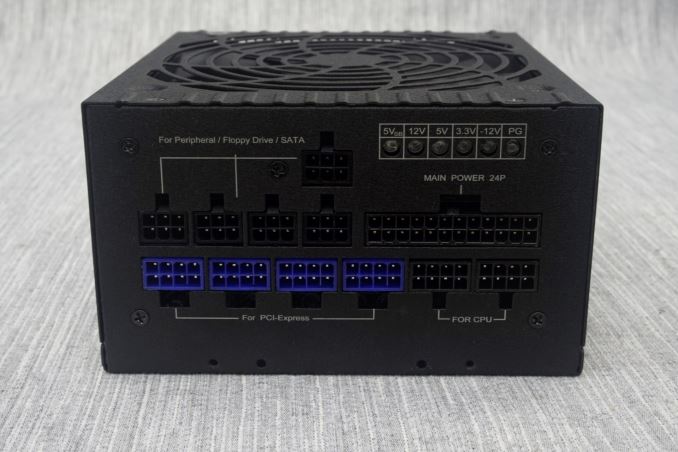The Rosewill Quark Series Power Supply Review (750W, 850W, 1000W, 1200W)
by E. Fylladitakis on January 13, 2016 9:00 AM EST- Posted in
- Cases/Cooling/PSUs
- Rosewill
- 80Plus Platinum
External Appearance
Rosewill went with the common "black goes with everything" approach for their Quark series units. The otherwise simple chassis is sprayed with a textured black paint that creates a sandstone-like visual effect. Instead of installing a removable finger guard, Rosewill cut the top cover to resemble a warped spider's web. There are no stickers or decorations on the sides of the chassis, the sticker with the specifications of the PSUs is placed at the top side of the units. The three most powerful Quark PSUs share the same exact chassis, while the 750W version is only slightly shorter.
The rear side of the PSUs is relatively uninteresting, with just a typical on/off switch and an AC power cable connector to be found there. Perhaps the only noteworthy observation is that the 750W unit has a smaller switch, as the larger units naturally have to cope with a larger input current.
While it is not strange for the rear side of these PSUs to be very similar, their front sides are peculiarly identical as well. All of the units share the same number of connectors, even though the smaller units do not come with enough cables for them. All of the connectors are black, with the exception of the PCI-Express connectors, which are blue. There are also six self-test LEDs near the top, five for the main voltage lines and one for the "Power Good" signal. These can be used to diagnose basic PSU issues.
Internal Design
Another difference between the 750W Quark and the more powerful versions is the fan. The 750W version has a Yate Loon D14BH-12 fan installed, a very powerful 140 mm fan, with a ball bearing engine and a maximum rotational speed of 2800 RPM. For the more powerful models, Rosewill went with a slightly smaller Young Lin Tech model, the DFS132512H, a 135 mm fan with a "hybrid" self-lubricating bearing and a maximum rotational speed of just 1700 PRM. Why Rosewill is installing such a powerful fan in the smaller models eludes us, as units capable of 80Plus Platinum efficiency with such a power output do not require these levels of airflow.
A glance on the insides of the Quark series PSUs instantly reveals that the 750W version is based on a similar, yet different platform than the rest. All are made by Enhance Electronics, with the 750W based on the 13XX Platinum platform and the more powerful units on the boosted 13XX Platinum GT platform. The 750W version has similar but notably smaller heatsinks and main transformer, while the secondary conversion stage MOSFETs can be seen from the top side of the main PCB, next to the transformer. The three larger PSUs have a larger secondary side heatsink and the secondary conversion MOSFETs are placed underneath the main PCB.
There is virtually no design difference between the 850W, 1000W and 1200W PSUs. Only the size and suppliers of the components change, with the mere exception that the 850W PSU has one input bridge rectifier and the larger units have two, with an extra smaller heatsink sandwiched between them.
The filtering stage of the 750W version consists of four Y capacitors, two X capacitors, two filtering inductors and a surge suppression MOV. Panasonic supplies the APFC 450V/560μF capacitor and all of the secondary side electrolytic capacitors come from Nippon Chemi-Con. Teapo supplies the polymer capacitors.
Enhance boosted the filtering stage of the 850W-1200W units slightly by adding two extra X capacitors. Rosewill's choice of component suppliers with these three models is very messy, hinting that the company is using whichever supplier is available and cost-effective at the time. The 850W version has its 420V/330μF primary capacitors supplied by Matsushita, its secondary side electrolytics are a mix of Nichicon, Unicon, Nippon Chemi-Con and Rubicon products, with Teapo supplying the polymers. The 1000W version came with two Nippon Chemi-Con 450V/390μF APFC capacitors, a mix of Nichicon, Unicon, Nippon Chemi-Con and Rubicon electrolytic capacitors, with Teapo and Dura Tech supplying the electrolytics. Finally, the 1200W version comes with Matsushita 420V/470μF APFC capacitors, a mix of Unicon, Nippon Chemi-Con, Nichicon and Dura Tech electrolytics, and another mix of Teapo, Nichicon and Dura Tech polymer capacitors.









































34 Comments
View All Comments
RaduZ - Thursday, January 14, 2016 - link
What's so great about these PSUs ? That platinum raiting means nothing... I was looking at the 750W one, if you compare it to lets say the Super Flower Leadex 750W Gold (or EVGA Supernova for the US market) it has the same price, in tests the SF has almost the same eficiency and way better regulation and better ripple control. (both are 130$ on newegg)kaborka - Monday, January 18, 2016 - link
One thing that is really important to me to see in a PSU review is whether it will work with a non-sinewave UPS or if the active PFC will shut it down. I have a significant investment in older UPS units and need compatible PSUs.shadowjk - Saturday, January 23, 2016 - link
Amen to that! This is very interesting to me too.Not only whether the Active PFC will cause problems, but also for us europeans whether the components such as the capacitors on the PSU can withstand the higher peak to peak voltage created by modified sine UPSes as compared to the peak to peak voltage of a real sine wave.
Oxford Guy - Friday, January 22, 2016 - link
"What surprised us was the acoustics performance of the 750W version, which is greatly inferior to that of the significantly more powerful units."It's not surprising. Ball bearing fans are noisier, especially models rated for that RPM. Single ball bearing fans are the worst.